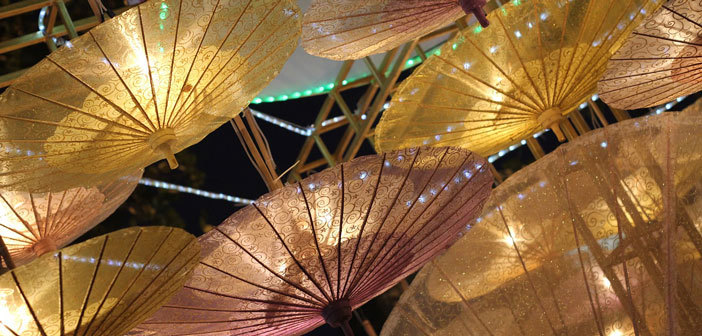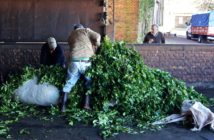Thailand, famed for its many world heritage sites and spicy, herb-infused cuisine, also has a rich tea and coffee culture that rewards explorers. During numerous trips to Thailand, I have drunk tea from cups, glasses, and even plastic bags. In Thailand, warm familiar beverages, as well as surprising ones, enrich my journeys.
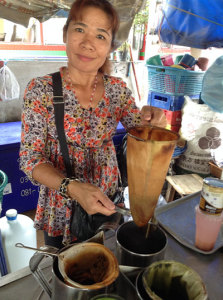 After a long absence, the first glass of Thai tea is always shockingly sugary. When I return to Thailand, my first beverage is usually from an outdoor stall, where I watch the brewing process step by step. The tea maker repeatedly pours hot water though a dark tea-stained cotton tea sock filled with a fistful of tea dust. Sometimes the sock is left to sit in hot water. The resulting orange-tinted Assam tea is poured into a glass. The tea maker adds spoons of gooey sweetened condensed milk and sugar.
After a long absence, the first glass of Thai tea is always shockingly sugary. When I return to Thailand, my first beverage is usually from an outdoor stall, where I watch the brewing process step by step. The tea maker repeatedly pours hot water though a dark tea-stained cotton tea sock filled with a fistful of tea dust. Sometimes the sock is left to sit in hot water. The resulting orange-tinted Assam tea is poured into a glass. The tea maker adds spoons of gooey sweetened condensed milk and sugar.
Finding a traditional stall selling Thai tea is simple even if you cannot read Thai. Look for pyramidal stacks of condensed milk cans on countertops. While sipping your tea, carefully observe your surroundings to learn about Thai culture. The Thai people revere their king and queen and Buddhism. It is highly likely you will see photographs of the royal family or respected monks on the walls of shops or panels around tea stalls. Many Thais believe spirits inhabit buildings, including tea shops, therefore they have shrines on the premises. The owner of one tea stall I visited placed a bottle of soda and a glass of condensed milk as offerings before a minuscule shrine affixed to the flimsy wall.
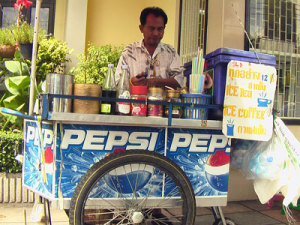 Being entrepreneurial seems to be a Thai characteristic. Setting up a tea stall does not require land or much money. They are almost everywhere in poor and remote areas. Some tea shops are simply carts wheeled up to the sides of buses or street corners. Homeowners place a table and chairs in front of their homes and have a mini tea store. I bought a cup of tea from a weathered gentleman whose “shop”, in the bright sun on a dusty road, was just a counter without chairs. As buses whizzed past, he and I shared a moment in tea time.
Being entrepreneurial seems to be a Thai characteristic. Setting up a tea stall does not require land or much money. They are almost everywhere in poor and remote areas. Some tea shops are simply carts wheeled up to the sides of buses or street corners. Homeowners place a table and chairs in front of their homes and have a mini tea store. I bought a cup of tea from a weathered gentleman whose “shop”, in the bright sun on a dusty road, was just a counter without chairs. As buses whizzed past, he and I shared a moment in tea time.
Besides ordering tea from small shops, I also tasted tea and tea-based foods sold in glitzy shopping malls and fancy coffee shops, many of which sell unique beverages I had never previously experienced in Thailand or elsewhere. Countless products and shops had names related to Japan, even though the connections are tenuous (Japanese culture is popular in Thailand). For example, a frothy green tea frappe was named Hokkaido Matcha, but tea plants cannot survive Hokkaido’s freezing winters. Some tea advertisements have nonsensical Japanese words.
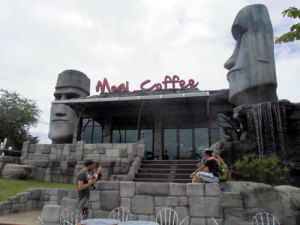 In two atypical coffee shops that I enjoyed visiting, the tea disappointed me. Five-meter-high replicas of the famous Easter Island heads drew me into one shop. The traditional Thai tea I requested was so full of fluorescent orange food coloring that I was scared to drink any of it at all. After a few sips, I left it. In a luxurious shop, the barista drew a beautiful flowering plant on the froth of a green-tea cappuccino, but it tasted like milk with gritty matcha powder. My favorite coffee shop serving tea was an unpretentious one with a deck overlooking a pond, banana trees, and rice fields. Drinking a simple black tea while surrounded by silent greenery was fantastic.
In two atypical coffee shops that I enjoyed visiting, the tea disappointed me. Five-meter-high replicas of the famous Easter Island heads drew me into one shop. The traditional Thai tea I requested was so full of fluorescent orange food coloring that I was scared to drink any of it at all. After a few sips, I left it. In a luxurious shop, the barista drew a beautiful flowering plant on the froth of a green-tea cappuccino, but it tasted like milk with gritty matcha powder. My favorite coffee shop serving tea was an unpretentious one with a deck overlooking a pond, banana trees, and rice fields. Drinking a simple black tea while surrounded by silent greenery was fantastic.
Other unusual tea beverages were the black, green, and other flavors of bubble teas, sometimes called pearl teas. Previously, I had only seen them in Taiwan. The bubbles or pearls are soft balls of sweetened tapioca or black rice that are at the bottom of a glass of milky sweetened tea. When sucking the tea through a straw, the bubbles get temporarily stuck before popping up into the mouth, a sweet surprise.
The Thai people are adept at reinventing foreign foods and drinks to match Thai tastes. If you enjoy Thai food, but have not yet visited Thailand, go soon. Your mouth will thank you.

